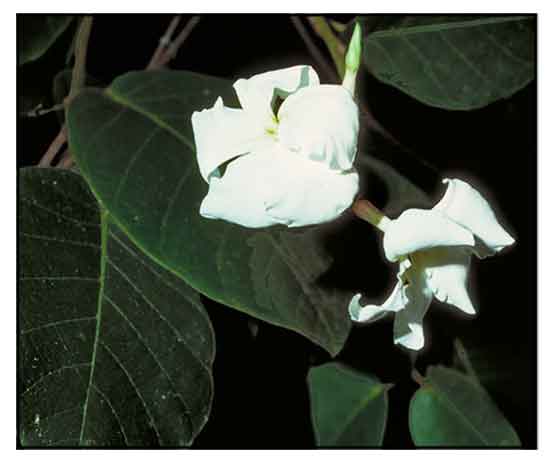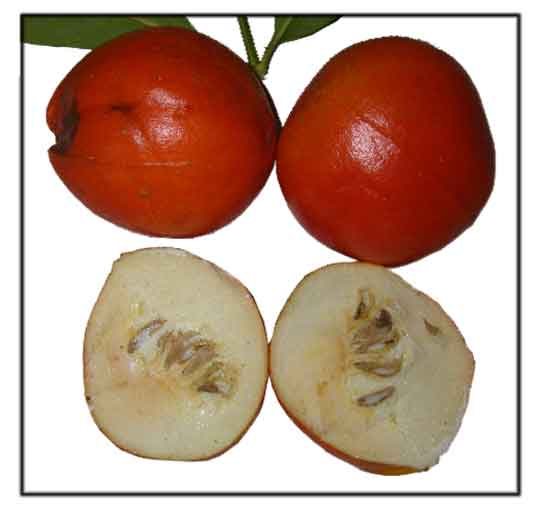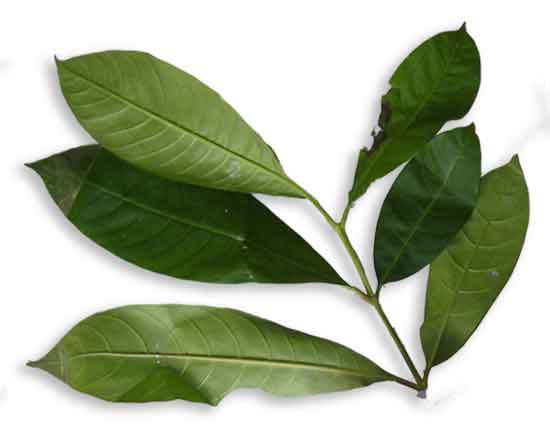 Gen info Gen info
• Voacanga is a genus of plants in the family Apocynaceae found in Africa, Southeast Asia, New Guinea, and Australia.
• As of 2013, the World Checklist of Selected Plant Families lists 13 species. Four are found in the Philippines: Voacanga foetida, V. globosa, V. grandifolia, and V. megacarpa. (2)
• Etymology: The genus was described in 1806 by Du Petit Thouars, who named it for the Madagascan words voa, meaning "fruit", and acanga, meaning "guinea fowl", referring to the spotted fruits. (8)
• The genus was described independently by Blume in 1826 as Orchipeda as O. foetida from Java. The genus and species epithets traveled a taxonomic journey until Rolfe (1883) reduced the last genus name to a synonym of Voacanga, and since then all later taxa have been described directly as species of Voacanga. (8)
• Voacanga grandifolia is considered not only the most widespread of Asian species, but also the most variable.
The leaves can be sessile and size-variable. Flowers also exhibit great variation. Fruits of Tabernaemontana aurantica are often confused with V. grandifolia, with leaves being very similar.
(Agri. Univ. Wageningen Papers, 1985) (8)
 Botany Botany
• Usually grows into a small tree but also flowers and fruits as a shrub. Twigs, petioles and leaves produce a copious milky exudate when cut or damaged. Leaf blades elliptic to obovate, about 10-33 x 5-13 cm, petioles about 0.5-2 cm long. One leaf of each pair of leaves is usually much smaller than the other. Lateral veins about 12-15 on each side of the midrib, curving but not forming definite loops inside the blade margin. Numerous peg-like glands or processes visible between the petioles and twigs. Short, erect, fleshy hairs usually visible on the underside of the leaf blades. Flowers about 4-7 cm diam. Calyx tube about 18 mm long, lobes about 5 mm long. Corolla tube about 9-24 mm long, lobes about 10-40 mm long. Anthers sessile, about 3 x 1 mm, apex acuminate, base sagittate, attached to the inner surface of the corolla tube about 2-7 mm from the top. Carpels free or slightly connate at the base. Style glabrous, about 19 mm long. Stigma capitate. Fruiting carpels transversely elliptic, up to about 12 x 15 x 10 cm. Aril orange. Seeds dark brown, about 8-13 x 4-7 x 3-6 mm, testa papillose. Embryo curved, about 6-7.5 mm long. Cotyledons suborbicular, about 2.7-4 mm diam., apex truncate, base cordate. (4)
• Dichotomously branched, laticiferous trees or shrubs, 2-6 m tall. Bark grayish or yellowish, smooth or pustular. Leaves opposite, often in unequal pairs, sessile or subsessile, amplexicaule; lamina broadly elliptic to oblanceolate, 24-47 x8-16 cm, acute or acuminate at apex, rounded or auriculate at base,  entire, green above, pale below; secondary veins 15-25 pairs, raised below, glabrous except on nerves below. Inflorescence long-peduncled, erect or drooping, first branching dichotomous, further branching cymose, laxly flowered, glabrous. Peduncle stout, 9-20 cm long. Flowers 5-merous, pedicelled. Pedicels to 2.5 cm long. Bracteoles deciduous, ovate, to 8 mm long. Calyx somewhat companulate, divided to middle, glabrous, with many basal glands within and shedding with the corolla; lobes 5, suborbicular, almost as long as tube. Corolla large, rotate or salver-shaped, to 7 cm across; tube to 1.7 cm long, longer than calyx, twisted; lobes 5, overlapping to the left in bud, 2 cm across, obovate-truncate or rounded, spreading. Stamens 5, inserted at the mouth of the corolla tube; filaments short; anthers sagittate, to 5 mm long, cohering with the stigma. Disc 5-lobed, yellow. Ovary 2-carpellary, apocarpous, many-ovuled; style to 1.6 cm long; stigma acute with a ring at base. Fruits of two, recurved or divaricate mericarps, somewhat elongate-reniform or obovoid-oblong, yellow or green with many pale gray or brownish warts, glabrous, 7-8 cm long. Seeds many, ovoid, dark brown, to 8 mm long; testa rugose; aril orange red. (3) entire, green above, pale below; secondary veins 15-25 pairs, raised below, glabrous except on nerves below. Inflorescence long-peduncled, erect or drooping, first branching dichotomous, further branching cymose, laxly flowered, glabrous. Peduncle stout, 9-20 cm long. Flowers 5-merous, pedicelled. Pedicels to 2.5 cm long. Bracteoles deciduous, ovate, to 8 mm long. Calyx somewhat companulate, divided to middle, glabrous, with many basal glands within and shedding with the corolla; lobes 5, suborbicular, almost as long as tube. Corolla large, rotate or salver-shaped, to 7 cm across; tube to 1.7 cm long, longer than calyx, twisted; lobes 5, overlapping to the left in bud, 2 cm across, obovate-truncate or rounded, spreading. Stamens 5, inserted at the mouth of the corolla tube; filaments short; anthers sagittate, to 5 mm long, cohering with the stigma. Disc 5-lobed, yellow. Ovary 2-carpellary, apocarpous, many-ovuled; style to 1.6 cm long; stigma acute with a ring at base. Fruits of two, recurved or divaricate mericarps, somewhat elongate-reniform or obovoid-oblong, yellow or green with many pale gray or brownish warts, glabrous, 7-8 cm long. Seeds many, ovoid, dark brown, to 8 mm long; testa rugose; aril orange red. (3)
Distribution
- Native to the Philippines.
- Also native to Jawa, Lesser Sunda Is., Maluku, New Guinea, Queensland, Sulawesi. (1)
Constituents
- Study of leaves isolated two new bisindole alkaloids, 12′-O-demethyl-vobtusine-5-lactam and isovobtusine-N-oxide (1 and 2), along with two known bisindole alkaloids. (see study below) (5)
- GC-MS analysis of ethanol extract of leaves detected major compounds of propanoic acid (77.5%), meso-erythritol (36.2%), 2,3,4 trihydroxybutyric acid (35.6%), D-pinnitol (44.9%), myo-inositol (40.4%), hexadecanoic acid (91.8%) and octadecanoic acid (43.3%). (see study below) (6)
- Extraction yield of leaf extract was 20.71% w/w. Total phenolic content was 36.00 mg GAE/g, while total flavonoid content was 21.00 mg QE/g extract. (see study below) (6)
- Study of bark of Voacanga grandifolia isolated five new indole alkaloids, voacalgines A-E (1-5), consisting of a C-mavacurine type skeleton, with 2,3-dihydroxybenzoate moiety. (see study below) (7)
- Study of extracts yielded non-alkaloid compounds: ß-sitosterol, lupeol acetate, and the alkaloid rhazine. (Majumbar & Dinda, 1974)
Properties
- Yields a milkly exudate when cut or damaged, similar to many Apocynaceae plants.
- Studies have suggested antioxidant, hepatoprotective, cytotoxic properties.
Parts used
Leaves, bark.
Uses
Edibility
- No information found on fruit edibility.
Folkloric
- No reported folkloric medicinal use in the Philippines.
- In traditional medicines, used for fever, malaria, and stomach pain.
- In Indonesia, scrapings from inner bark layer rubbed on skin to treat dermatitis. (9)
Studies
• Antimalarial / Leaves: Study of leaves isolated two new bisindole alkaloids, 12′-O-demethyl-vobtusine-5-lactam and isovobtusine-N-oxide (1 and 2), along with two known bisindole alkaloids. Compound 1 and 2 showed potent antimalarial activity against Plasmodium falciparum 3D7 and very low cytotoxicity against a human cell line, HepG2. (5)
• Hepatoprotective / Antioxidant / Alcohol-Induced Toxicity / Leaves: Study evaluated an ethanol extract of V. grandifolia leaves for hepatoprotective and antioxidant potential against ethanol-induced liver toxicity in Sprague-Dawley rats. V. gradifolia extract (100 and 200 mg/kg) increased the concentration of enzymatic antioxidants while diminishing the levels of inflammatory cytokines and biochemical indicators. qRT-PCR assay showed upregulation of antiapoptotic gene expression and downregulation of pro-apoptotic gene expression. Scavenging activities on DPPH radical were 22%, 35%, 47%, 66%, and 85% at 25, 50, 75, 100, and 125 µg/ml, respectively, with IC50 of 56 µg/mL. Reducing power was 31.21 mg ascorbic acid equivalents/g of leaf extract. Extract also improved hepatic architecture of ethanol-intoxicated rats. Results demonstrated hepatoprotective activity. (see constituents above) (6)
• Voacalgines / Cytotoxic Indole Alkaloids / Bark: Study of bark of Voacanga grandifolia isolated five new indole alkaloids, voacalgines A-E (1-5), and were tested for cytotoxic activity against HL-60, HCT116, and MCF cell lines. Voacalgine A showed moderate cell growth inhibitory activities against HL-60 and HCT116 cells with IC50s of of 12.1 µM and 45.7 µM, respectively. (7)
Availability
Wild-crafted.
|

![]()




 Botany
Botany
